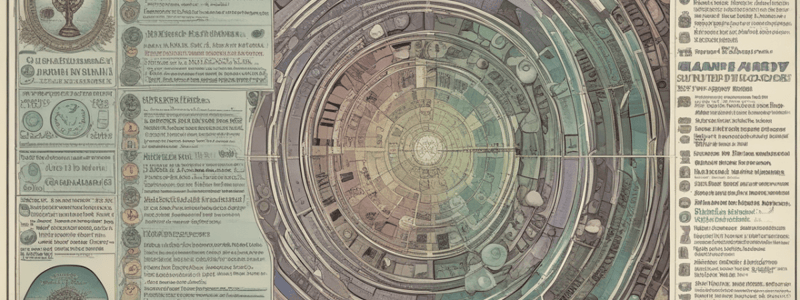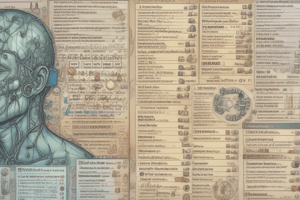Podcast
Questions and Answers
What is the main characteristic of Schedule 3 drugs?
What is the main characteristic of Schedule 3 drugs?
- They can be verbally ordered and refilled up to five times within 6 months (correct)
- They require a written prescription within 72 hours
- They are not available for regular use except for investigational purposes
- They have a high potential for abuse
Which category for pregnancy indicates that controlled studies fail to demonstrate a risk to the fetus in the first trimester?
Which category for pregnancy indicates that controlled studies fail to demonstrate a risk to the fetus in the first trimester?
- Category D
- Category B
- Category A (correct)
- Category C
What is a defining attribute of Schedule 1 drugs?
What is a defining attribute of Schedule 1 drugs?
- They have a valid medical use but high potential for abuse
- They can be refilled up to five times within 6 months
- They include nonnarcotic analgesics and antianxiety agents
- Not available for regular use except for investigational purposes (correct)
Which drugs have a low potential for abuse and limited physical dependence?
Which drugs have a low potential for abuse and limited physical dependence?
What differentiates Schedule 2 drugs from Schedule 3 drugs?
What differentiates Schedule 2 drugs from Schedule 3 drugs?
What is the primary feature of Schedule 5 drugs?
What is the primary feature of Schedule 5 drugs?
Under which category for pregnancy does the possibility of fetal harm appear remote?
Under which category for pregnancy does the possibility of fetal harm appear remote?
What is a distinguishing characteristic of Schedule 2 drugs?
What is a distinguishing characteristic of Schedule 2 drugs?
Which drugs are included in Schedule 4?
Which drugs are included in Schedule 4?
What sets Schedule 3 drugs apart from Schedule 4 drugs?
What sets Schedule 3 drugs apart from Schedule 4 drugs?
Which group of individuals is mentioned to have a decreased risk of suicide when taking SSRIs?
Which group of individuals is mentioned to have a decreased risk of suicide when taking SSRIs?
What somatic symptom is most commonly seen in children and teenagers with no identifiable physical cause?
What somatic symptom is most commonly seen in children and teenagers with no identifiable physical cause?
What is the boxed warning associated with the use of antidepressants in children, adolescents, and young adults?
What is the boxed warning associated with the use of antidepressants in children, adolescents, and young adults?
Which type of medication can cause QT interval prolongation and neuroleptic malignant syndrome?
Which type of medication can cause QT interval prolongation and neuroleptic malignant syndrome?
What is the first-line therapy recommended by the APA for Obsessive-Compulsive Disorder (OCD)?
What is the first-line therapy recommended by the APA for Obsessive-Compulsive Disorder (OCD)?
Which age group is mentioned to have an increased risk of suicidal ideation with the use of antidepressants?
Which age group is mentioned to have an increased risk of suicidal ideation with the use of antidepressants?
Which medication is considered 1st line for treating elderly depression?
Which medication is considered 1st line for treating elderly depression?
What is the main adverse event associated with Benzodiazepines (BZDs)?
What is the main adverse event associated with Benzodiazepines (BZDs)?
Apart from abdominal pain, what is another common somatic symptom seen in children and teenagers with no physiological cause?
Apart from abdominal pain, what is another common somatic symptom seen in children and teenagers with no physiological cause?
Which medication can be an option for individuals with a history of substance abuse when treating anxiety?
Which medication can be an option for individuals with a history of substance abuse when treating anxiety?
What is the primary consideration when prescribing drugs in pregnancy?
What is the primary consideration when prescribing drugs in pregnancy?
What is the primary purpose of Phase III Clinical Trials?
What is the primary purpose of Phase III Clinical Trials?
What is the primary contributor to morbidity and mortality in elderly individuals?
What is the primary contributor to morbidity and mortality in elderly individuals?
What is the primary cause of preventable medication problems in elderly individuals?
What is the primary cause of preventable medication problems in elderly individuals?
What is the primary source of polypharmacy in elderly individuals?
What is the primary source of polypharmacy in elderly individuals?
What is the primary consequence of polypharmacy in elderly individuals?
What is the primary consequence of polypharmacy in elderly individuals?
What is the primary role of Phase IV Clinical Trials?
What is the primary role of Phase IV Clinical Trials?
What is the primary consideration when evaluating the safety of a drug during pregnancy?
What is the primary consideration when evaluating the safety of a drug during pregnancy?
What is the primary purpose of Preclinical Trials?
What is the primary purpose of Preclinical Trials?
What is the primary concern with NSAIDs in elderly individuals?
What is the primary concern with NSAIDs in elderly individuals?
Which type of antidepressant is known to be metabolized by the liver and requires titration before discontinuation?
Which type of antidepressant is known to be metabolized by the liver and requires titration before discontinuation?
Which class of antidepressants is associated with adverse effects such as nausea, insomnia, and decreased libido, especially in serotonin storm and bipolar patients?
Which class of antidepressants is associated with adverse effects such as nausea, insomnia, and decreased libido, especially in serotonin storm and bipolar patients?
Which antidepressant class is known to increase the relative concentrations of both serotonin and norepinephrine, with a varying degree of serotonergic or noradrenergic activity depending on the dose?
Which antidepressant class is known to increase the relative concentrations of both serotonin and norepinephrine, with a varying degree of serotonergic or noradrenergic activity depending on the dose?
Which class of antidepressants is considered 3rd line and is primarily used as potent inhibitors of norepinephrine reuptake with fewer effects on serotonin?
Which class of antidepressants is considered 3rd line and is primarily used as potent inhibitors of norepinephrine reuptake with fewer effects on serotonin?
Which antidepressant category is known for causing cholinergic side effects and being useful for pain control?
Which antidepressant category is known for causing cholinergic side effects and being useful for pain control?
Which type of antidepressants is similar to TCAs in its effects but causes sedation, increased appetite, and reduced insomnia?
Which type of antidepressants is similar to TCAs in its effects but causes sedation, increased appetite, and reduced insomnia?
Which antidepressant acts as a weak serotonin receptor antagonist and is highly sedating at therapeutic doses, commonly used to treat insomnia?
Which antidepressant acts as a weak serotonin receptor antagonist and is highly sedating at therapeutic doses, commonly used to treat insomnia?
Which antidepressant class leads to decreased degradation of norepinephrine, serotonin, and dopamine in the synaptic cleft, but is associated with severe hypertensive crisis?
Which antidepressant class leads to decreased degradation of norepinephrine, serotonin, and dopamine in the synaptic cleft, but is associated with severe hypertensive crisis?
Which class of antidepressants is known for being broad-spectrum but requires the strict avoidance of tyramine-containing foods due to the risk of hypertensive crisis?
Which class of antidepressants is known for being broad-spectrum but requires the strict avoidance of tyramine-containing foods due to the risk of hypertensive crisis?
Which antidepressant category is highly sedating at therapeutic doses and often used to treat insomnia?
Which antidepressant category is highly sedating at therapeutic doses and often used to treat insomnia?
Which medication can be considered first-line for preventively treating migraines?
Which medication can be considered first-line for preventively treating migraines?
What is a common adverse reaction to triptans indicated in the text?
What is a common adverse reaction to triptans indicated in the text?
If a patient experiences heartburn as a side effect, which medication could they potentially be using?
If a patient experiences heartburn as a side effect, which medication could they potentially be using?
What symptom should raise concern about a possible severe headache based on the text?
What symptom should raise concern about a possible severe headache based on the text?
Which class of medications is recommended as a second-line abortive treatment for migraines in the text?
Which class of medications is recommended as a second-line abortive treatment for migraines in the text?
What adverse reaction might justify the avoidance of triptans in a patient with coronary artery disease?
What adverse reaction might justify the avoidance of triptans in a patient with coronary artery disease?
Which medication is a drug of choice in status migrainosus and for triptan resistance or failure?
Which medication is a drug of choice in status migrainosus and for triptan resistance or failure?
If a patient reports weakness and numbness, which red flag headache symptom should be considered based on the text?
If a patient reports weakness and numbness, which red flag headache symptom should be considered based on the text?
Which non-pharmacological intervention is recommended as a first-line preventive treatment in the text?
Which non-pharmacological intervention is recommended as a first-line preventive treatment in the text?
If a patient experiences insomnia following medication use, which drug may be the culprit according to the text?
If a patient experiences insomnia following medication use, which drug may be the culprit according to the text?
What is the primary reason for closely monitoring serum lithium levels?
What is the primary reason for closely monitoring serum lithium levels?
What is the recommended range for serum lithium concentrations in most patients for a therapeutic response?
What is the recommended range for serum lithium concentrations in most patients for a therapeutic response?
What condition contraindicates the use of lithium?
What condition contraindicates the use of lithium?
Which age group needs dose adjustments when prescribing lithium?
Which age group needs dose adjustments when prescribing lithium?
In the treatment of acute severe mania, lithium is typically administered in combination with which type of drug?
In the treatment of acute severe mania, lithium is typically administered in combination with which type of drug?
What is a significant interaction to be mindful of when prescribing lithium?
What is a significant interaction to be mindful of when prescribing lithium?
What is a common side effect of lithium therapy related to its serum levels?
What is a common side effect of lithium therapy related to its serum levels?
Why is it essential to adjust doses of drugs interacting with lithium?
Why is it essential to adjust doses of drugs interacting with lithium?
For which purpose is lithium primarily used in treating bipolar disorder?
For which purpose is lithium primarily used in treating bipolar disorder?
In which patients might a therapeutic response be observed at lower serum lithium levels like 0.6 mEq/L?
In which patients might a therapeutic response be observed at lower serum lithium levels like 0.6 mEq/L?
Flashcards are hidden until you start studying




